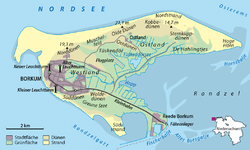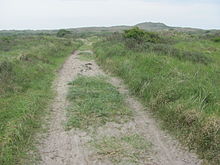Ostlandbahn
| Borkum roadstead | |||||||||||||||||||||||||||||||||||||||||||||||||||||||||||||||||||||||||||||||||
|---|---|---|---|---|---|---|---|---|---|---|---|---|---|---|---|---|---|---|---|---|---|---|---|---|---|---|---|---|---|---|---|---|---|---|---|---|---|---|---|---|---|---|---|---|---|---|---|---|---|---|---|---|---|---|---|---|---|---|---|---|---|---|---|---|---|---|---|---|---|---|---|---|---|---|---|---|---|---|---|---|---|
| Route length: | 8.6 km | ||||||||||||||||||||||||||||||||||||||||||||||||||||||||||||||||||||||||||||||||
| Gauge : | 900 mm ( narrow gauge ) | ||||||||||||||||||||||||||||||||||||||||||||||||||||||||||||||||||||||||||||||||
|
|||||||||||||||||||||||||||||||||||||||||||||||||||||||||||||||||||||||||||||||||
The Ostlandbahn was a narrow-gauge railway line with a gauge of 900 mm on the East Frisian North Sea island of Borkum , which - as an extension of the Borkumer Kleinbahn (BKB) - was built and operated from its Borkum station from 1908 by the Imperial Navy as a naval railway.
Infrastructure
The Ostlandbahn is named after the Borkum district and the eastern half of the island of the same name. It served to supply the military facilities of the Imperial Navy on the island . These emerged after Kaiser Wilhelm II declared the island of Borkum a sea fortress in 1902 . Most military facilities on the island were given - at least during the construction phase - a siding . In 1908 the route to the dune battery was built (approx. Km 5.3) and in 1912/13 it was extended to the Hörn battery (km 8.594). In 1915 a bypass track was laid around the Watt battery. The operational management of the line was not with the BKB, but with the railway operations department of the Borkum commandant's office . Separate operating regulations applied to both railway systems.
The Borkum sea fortress played no role in the First World War . Not a single shot was fired at the island. The Ostlandbahn was used militarily before and during the Second World War . But now there was also passenger traffic to the Borkum airfield and the racetrack, which led to disputes between the authorities because there was no approval from the small railway supervision.
There was no major damage to the Ostlandbahn during World War II. Rather, after the only significant air raid on the BKB train station and railway workshops in the municipality of Borkum on August 5, 1944, the “Schlüter track” provided a direct connection to the Borkum roadstead – Borkum railway, which made it possible to bypass Borkum town and train station to the east.
vehicles
The Navy used its own locomotives , railcars and wagons on the Ostlandbahn - and also on the BKB routes . There is no complete documentation for these vehicles . The use of the steam locomotives "KOMMANDANTUR BORKUM" (1914) and "KOMMANDANT" (taken over used in 1920), the diesel locomotives "LEER" (1935) and " EMDEN " (1942), a Wismar rail bus T2 (1939), a series of Draisines and passenger cars - including one for the commandant of Borkum Fortress. Among the military wagons there are distinctly exotic cars such as headlamp wagons and a wagon for the transport of washed up corpses .
End of the track
After the Second World War, the military facilities on Borkum were by the British occupying forces blew up and the Ostlandbahn - including the "Schlüter track" - had beyond the former military railway depot to be demolished on Barbaraweg. This work was completed in 1948. The railway depot at Barbaraweg was initially continued to be used by the BKB, but in 1958 it was abandoned in favor of the workshops west of the Borkum train station together with the access track from the local train station, the last remaining part of the Ostland Railway still in operation. The locomotive workshop of the former Barbaraweg depot was demolished. The two other halls of the BW are still standing today, the painting and carpentry workshop, which is used today by the German Red Cross , and the locksmith's shop, which is now shared by the North Domain Office and the Lower Saxony State Office for Water Management, Coastal Protection and Nature Conservation .
literature
- Volker Apfeld: Borkum - fortress in the sea. The interesting history of the Borkum sea fortress from its beginnings in 1902 to the closure of the Bundeswehr base in 1996 . Self-published, Borkum 2008, DNB 1003566537 .
- Jörg Reith: The Borkumer Inselbahn. In: The museum railway. 2/1975. (Reprint as a special print for the commissioning of the steam locomotive BORKUM. Borkum 1997)
- Hans Schweers: The Borkumer Kleinbahn and the ships of the AG "Ems" . Schweers + Wall, Cologne 2007, ISBN 978-3-89494-132-1 .




